Wei Yang Bryan Lim
Oblivionis: A Lightweight Learning and Unlearning Framework for Federated Large Language Models
Aug 12, 2025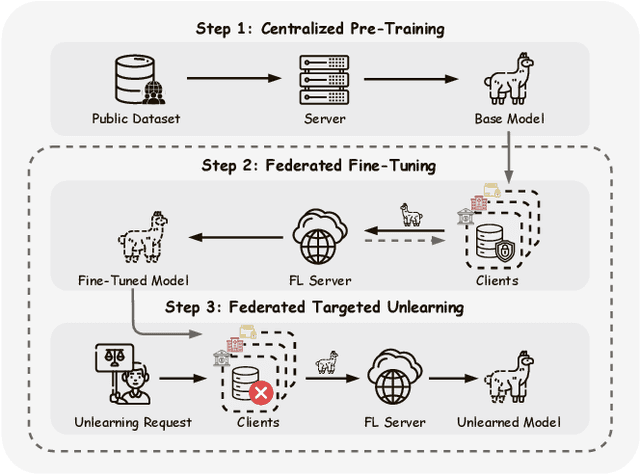

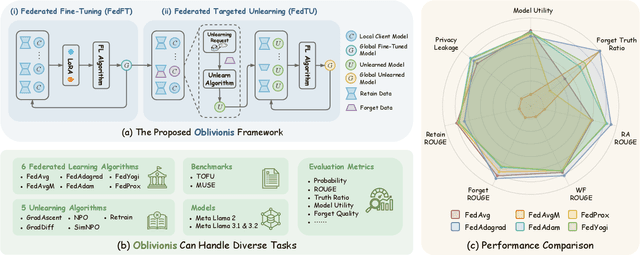
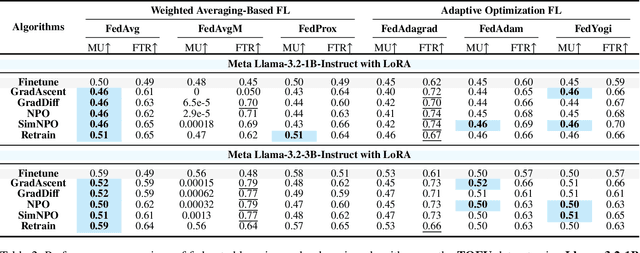
Abstract:Large Language Models (LLMs) increasingly leverage Federated Learning (FL) to utilize private, task-specific datasets for fine-tuning while preserving data privacy. However, while federated LLM frameworks effectively enable collaborative training without raw data sharing, they critically lack built-in mechanisms for regulatory compliance like GDPR's right to be forgotten. Integrating private data heightens concerns over data quality and long-term governance, yet existing distributed training frameworks offer no principled way to selectively remove specific client contributions post-training. Due to distributed data silos, stringent privacy constraints, and the intricacies of interdependent model aggregation, federated LLM unlearning is significantly more complex than centralized LLM unlearning. To address this gap, we introduce Oblivionis, a lightweight learning and unlearning framework that enables clients to selectively remove specific private data during federated LLM training, enhancing trustworthiness and regulatory compliance. By unifying FL and unlearning as a dual optimization objective, we incorporate 6 FL and 5 unlearning algorithms for comprehensive evaluation and comparative analysis, establishing a robust pipeline for federated LLM unlearning. Extensive experiments demonstrate that Oblivionis outperforms local training, achieving a robust balance between forgetting efficacy and model utility, with cross-algorithm comparisons providing clear directions for future LLM development.
SacFL: Self-Adaptive Federated Continual Learning for Resource-Constrained End Devices
May 01, 2025



Abstract:The proliferation of end devices has led to a distributed computing paradigm, wherein on-device machine learning models continuously process diverse data generated by these devices. The dynamic nature of this data, characterized by continuous changes or data drift, poses significant challenges for on-device models. To address this issue, continual learning (CL) is proposed, enabling machine learning models to incrementally update their knowledge and mitigate catastrophic forgetting. However, the traditional centralized approach to CL is unsuitable for end devices due to privacy and data volume concerns. In this context, federated continual learning (FCL) emerges as a promising solution, preserving user data locally while enhancing models through collaborative updates. Aiming at the challenges of limited storage resources for CL, poor autonomy in task shift detection, and difficulty in coping with new adversarial tasks in FCL scenario, we propose a novel FCL framework named SacFL. SacFL employs an Encoder-Decoder architecture to separate task-robust and task-sensitive components, significantly reducing storage demands by retaining lightweight task-sensitive components for resource-constrained end devices. Moreover, $\rm{SacFL}$ leverages contrastive learning to introduce an autonomous data shift detection mechanism, enabling it to discern whether a new task has emerged and whether it is a benign task. This capability ultimately allows the device to autonomously trigger CL or attack defense strategy without additional information, which is more practical for end devices. Comprehensive experiments conducted on multiple text and image datasets, such as Cifar100 and THUCNews, have validated the effectiveness of $\rm{SacFL}$ in both class-incremental and domain-incremental scenarios. Furthermore, a demo system has been developed to verify its practicality.
Unlearning through Knowledge Overwriting: Reversible Federated Unlearning via Selective Sparse Adapter
Feb 28, 2025



Abstract:Federated Learning is a promising paradigm for privacy-preserving collaborative model training. In practice, it is essential not only to continuously train the model to acquire new knowledge but also to guarantee old knowledge the right to be forgotten (i.e., federated unlearning), especially for privacy-sensitive information or harmful knowledge. However, current federated unlearning methods face several challenges, including indiscriminate unlearning of cross-client knowledge, irreversibility of unlearning, and significant unlearning costs. To this end, we propose a method named FUSED, which first identifies critical layers by analyzing each layer's sensitivity to knowledge and constructs sparse unlearning adapters for sensitive ones. Then, the adapters are trained without altering the original parameters, overwriting the unlearning knowledge with the remaining knowledge. This knowledge overwriting process enables FUSED to mitigate the effects of indiscriminate unlearning. Moreover, the introduction of independent adapters makes unlearning reversible and significantly reduces the unlearning costs. Finally, extensive experiments on three datasets across various unlearning scenarios demonstrate that FUSED's effectiveness is comparable to Retraining, surpassing all other baselines while greatly reducing unlearning costs.
STORM: A Spatio-Temporal Factor Model Based on Dual Vector Quantized Variational Autoencoders for Financial Trading
Dec 12, 2024Abstract:In financial trading, factor models are widely used to price assets and capture excess returns from mispricing. Recently, we have witnessed the rise of variational autoencoder-based latent factor models, which learn latent factors self-adaptively. While these models focus on modeling overall market conditions, they often fail to effectively capture the temporal patterns of individual stocks. Additionally, representing multiple factors as single values simplifies the model but limits its ability to capture complex relationships and dependencies. As a result, the learned factors are of low quality and lack diversity, reducing their effectiveness and robustness across different trading periods. To address these issues, we propose a Spatio-Temporal factOR Model based on dual vector quantized variational autoencoders, named STORM, which extracts features of stocks from temporal and spatial perspectives, then fuses and aligns these features at the fine-grained and semantic level, and represents the factors as multi-dimensional embeddings. The discrete codebooks cluster similar factor embeddings, ensuring orthogonality and diversity, which helps distinguish between different factors and enables factor selection in financial trading. To show the performance of the proposed factor model, we apply it to two downstream experiments: portfolio management on two stock datasets and individual trading tasks on six specific stocks. The extensive experiments demonstrate STORM's flexibility in adapting to downstream tasks and superior performance over baseline models.
Enhancing Federated Domain Adaptation with Multi-Domain Prototype-Based Federated Fine-Tuning
Oct 10, 2024



Abstract:Federated Domain Adaptation (FDA) is a Federated Learning (FL) scenario where models are trained across multiple clients with unique data domains but a shared category space, without transmitting private data. The primary challenge in FDA is data heterogeneity, which causes significant divergences in gradient updates when using conventional averaging-based aggregation methods, reducing the efficacy of the global model. This further undermines both in-domain and out-of-domain performance (within the same federated system but outside the local client). To address this, we propose a novel framework called \textbf{M}ulti-domain \textbf{P}rototype-based \textbf{F}ederated Fine-\textbf{T}uning (MPFT). MPFT fine-tunes a pre-trained model using multi-domain prototypes, i.e., pretrained representations enriched with domain-specific information from category-specific local data. This enables supervised learning on the server to derive a globally optimized adapter that is subsequently distributed to local clients, without the intrusion of data privacy. Empirical results show that MPFT significantly improves both in-domain and out-of-domain accuracy over conventional methods, enhancing knowledge preservation and adaptation in FDA. Notably, MPFT achieves convergence within a single communication round, greatly reducing computation and communication costs. To ensure privacy, MPFT applies differential privacy to protect the prototypes. Additionally, we develop a prototype-based feature space hijacking attack to evaluate robustness, confirming that raw data samples remain unrecoverable even after extensive training epochs. The complete implementation of MPFL is available at \url{https://anonymous.4open.science/r/DomainFL/}.
Enhancing Security and Privacy in Federated Learning using Update Digests and Voting-Based Defense
May 29, 2024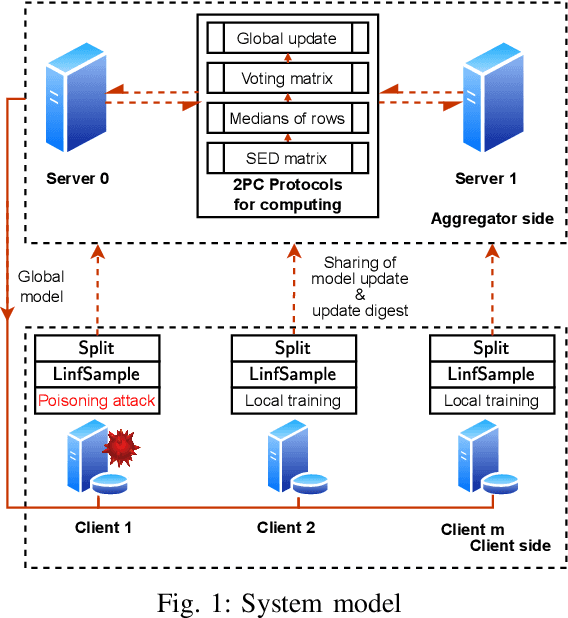
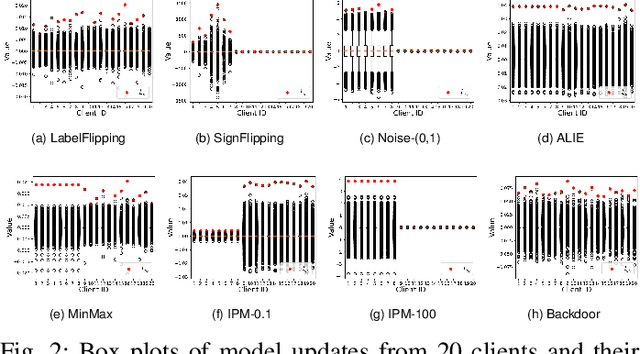

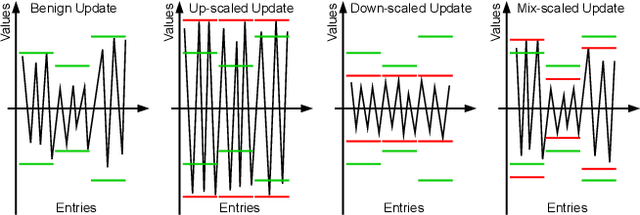
Abstract:Federated Learning (FL) is a promising privacy-preserving machine learning paradigm that allows data owners to collaboratively train models while keeping their data localized. Despite its potential, FL faces challenges related to the trustworthiness of both clients and servers, especially in the presence of curious or malicious adversaries. In this paper, we introduce a novel framework named \underline{\textbf{F}}ederated \underline{\textbf{L}}earning with \underline{\textbf{U}}pdate \underline{\textbf{D}}igest (FLUD), which addresses the critical issues of privacy preservation and resistance to Byzantine attacks within distributed learning environments. FLUD utilizes an innovative approach, the $\mathsf{LinfSample}$ method, allowing clients to compute the $l_{\infty}$ norm across sliding windows of updates as an update digest. This digest enables the server to calculate a shared distance matrix, significantly reducing the overhead associated with Secure Multi-Party Computation (SMPC) by three orders of magnitude while effectively distinguishing between benign and malicious updates. Additionally, FLUD integrates a privacy-preserving, voting-based defense mechanism that employs optimized SMPC protocols to minimize communication rounds. Our comprehensive experiments demonstrate FLUD's effectiveness in countering Byzantine adversaries while incurring low communication and runtime overhead. FLUD offers a scalable framework for secure and reliable FL in distributed environments, facilitating its application in scenarios requiring robust data management and security.
Sustainable AIGC Workload Scheduling of Geo-Distributed Data Centers: A Multi-Agent Reinforcement Learning Approach
Apr 17, 2023Abstract:Recent breakthroughs in generative artificial intelligence have triggered a surge in demand for machine learning training, which poses significant cost burdens and environmental challenges due to its substantial energy consumption. Scheduling training jobs among geographically distributed cloud data centers unveils the opportunity to optimize the usage of computing capacity powered by inexpensive and low-carbon energy and address the issue of workload imbalance. To tackle the challenge of multi-objective scheduling, i.e., maximizing GPU utilization while reducing operational costs, we propose an algorithm based on multi-agent reinforcement learning and actor-critic methods to learn the optimal collaborative scheduling strategy through interacting with a cloud system built with real-life workload patterns, energy prices, and carbon intensities. Compared with other algorithms, our proposed method improves the system utility by up to 28.6% attributable to higher GPU utilization, lower energy cost, and less carbon emission.
Economics of Semantic Communication System: An Auction Approach
Aug 02, 2022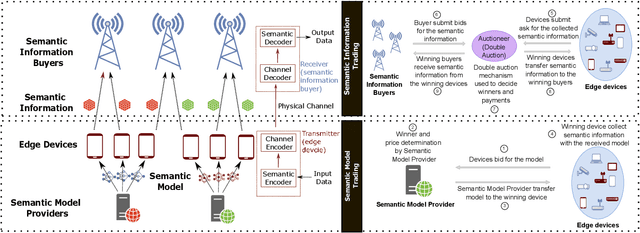
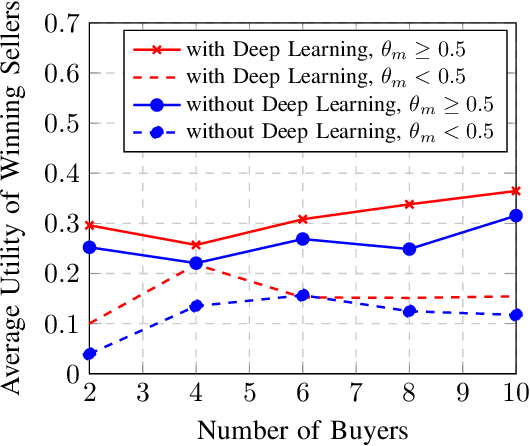
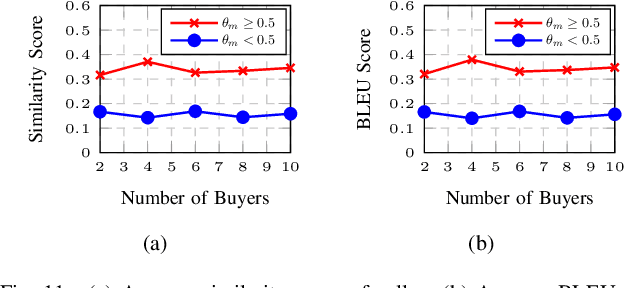
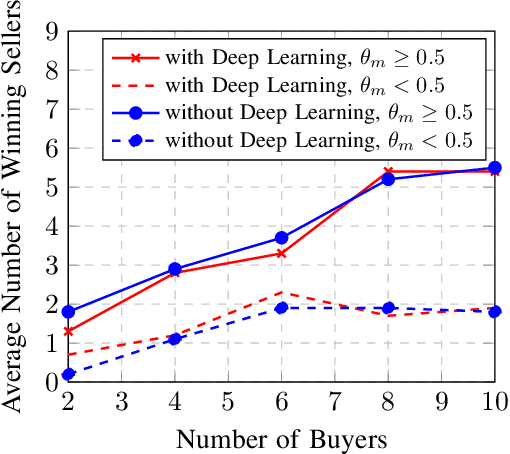
Abstract:Semantic communication technologies enable wireless edge devices to communicate effectively by transmitting semantic meaning of data. Edge components, such as vehicles in next-generation intelligent transport systems, use well-trained semantic models to encode and decode semantic information extracted from raw and sensor data. However, the limitation in computing resources makes it difficult to support the training process of accurate semantic models on edge devices. As such, edge devices can buy the pretrained semantic models from semantic model providers, which is called "semantic model trading". Upon collecting semantic information with the semantic models, the edge devices can then sell the extracted semantic information, e.g., information about urban road conditions or traffic signs, to the interested buyers for profit, which is called "semantic information trading". To facilitate both types of the trades, effective incentive mechanisms should be designed. Thus, in this paper, we propose a hierarchical trading system to support both semantic model trading and semantic information trading jointly. The proposed incentive mechanism helps to maximize the revenue of semantic model providers in the semantic model trading, and effectively incentivizes model providers to participate in the development of semantic communication systems. For semantic information trading, our designed auction approach can support the trading between multiple semantic information sellers and buyers, while ensuring individual rationality, incentive compatibility, and budget balance, and moreover, allowing them achieve higher utilities than the baseline method.
Semantic Communication Meets Edge Intelligence
Feb 14, 2022



Abstract:The development of emerging applications, such as autonomous transportation systems, are expected to result in an explosive growth in mobile data traffic. As the available spectrum resource becomes more and more scarce, there is a growing need for a paradigm shift from Shannon's Classical Information Theory (CIT) to semantic communication (SemCom). Specifically, the former adopts a "transmit-before-understanding" approach while the latter leverages artificial intelligence (AI) techniques to "understand-before-transmit", thereby alleviating bandwidth pressure by reducing the amount of data to be exchanged without negating the semantic effectiveness of the transmitted symbols. However, the semantic extraction (SE) procedure incurs costly computation and storage overheads. In this article, we introduce an edge-driven training, maintenance, and execution of SE. We further investigate how edge intelligence can be enhanced with SemCom through improving the generalization capabilities of intelligent agents at lower computation overheads and reducing the communication overhead of information exchange. Finally, we present a case study involving semantic-aware resource optimization for the wireless powered Internet of Things (IoT).
Economics of Semantic Communication System in Wireless Powered Internet of Things
Oct 04, 2021

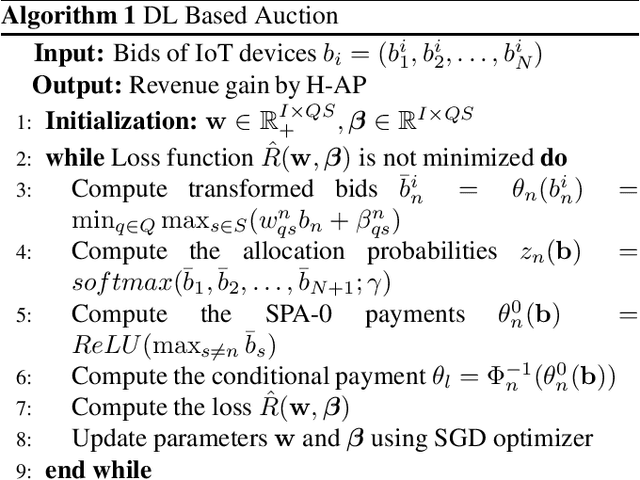
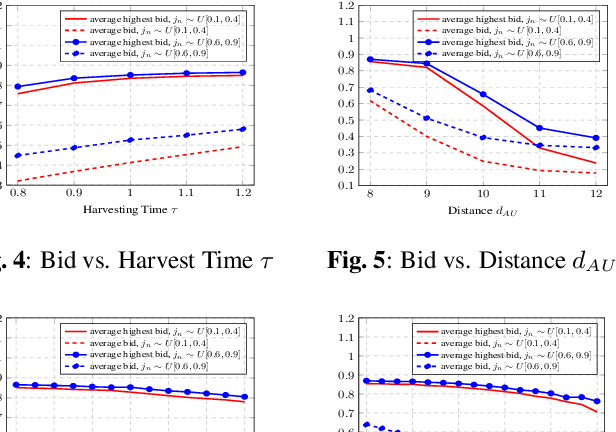
Abstract:The semantic communication system enables wireless devices to communicate effectively with the semantic meaning of the data. Wireless powered Internet of Things (IoT) that adopts the semantic communication system relies on harvested energy to transmit semantic information. However, the issue of energy constraint in the semantic communication system is not well studied. In this paper, we propose a semantic-based energy valuation and take an economic approach to solve the energy allocation problem as an incentive mechanism design. In our model, IoT devices (bidders) place their bids for the energy and power transmitter (auctioneer) decides the winner and payment by using deep learning based optimal auction. Results show that the revenue of wireless power transmitter is maximized while satisfying Individual Rationality (IR) and Incentive Compatibility (IC).
 Add to Chrome
Add to Chrome Add to Firefox
Add to Firefox Add to Edge
Add to Edge